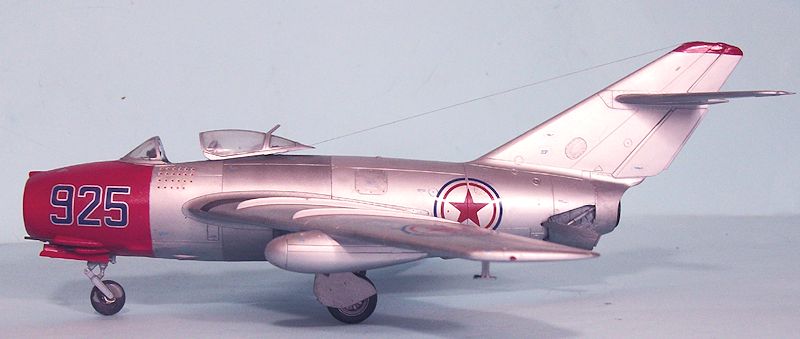
Tamiya 1/48 MiG-15bis
| KIT #: | 61043 |
| PRICE: | $27.00 when first released |
| DECALS: | Four options |
| REVIEWER: | Tom Cleaver |
| NOTES: | Currently OOP |

| HISTORY |
The MiG-15 in Korea:
The MiG-15 was a nightmare come
true for the United States Air Force in the fall of 1950: a Soviet jet fighter
that outperformed all U.S. fighters then operational in Korea War.
While it's true that history's first jet vs. jet combat, which involved a
Lockheed F-80C Shooting Star flown by Lt. Russell Brown of the 51st
Fighter Interceptor Wing and a MiG-15 that was likely flown by a Russian
"volunteer" ended in victory for the Shooting Star, it was luck and individual
pilot ability - not superior technology - that was responsible.
Those little aluminum dots over the Yalu with their swept wings sent a
shiver of fear through every American flyer in Korea.
That December of 1950, the 4th
Fighter Interceptor Wing - descendants of the American Eagles of the RAF and the
top-scoring U.S. fighter group of World War II - arrived in-theater, equipped
with the most advanced U.S. fighter, the North American F-86A "Sabre."
By the middle of the month, it had been
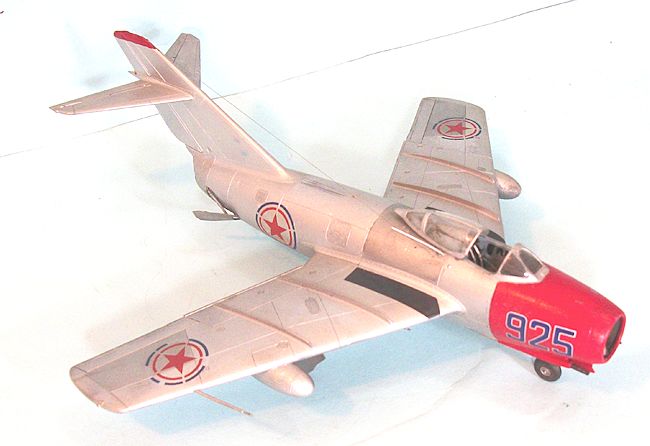 established
that the Sabre could take on the MiG-15 with confidence.
The two airplanes were closely similar, though the MiG-15 had superior
altitude capability, with a ceiling of 50,000 feet compared to the Sabre's best
altitude of 35,000 feet. Neither
had good armament for fighter-vs-fighter combat: the MiG-15's heavy cannon were
there to shoot down B-50 and B-36 bombers over the USSR, while the six 50
caliber machine guns of the Sabre didn't pack sufficient punch; one hit from the
37mm cannon or two or three from the 23mm cannons was good enough for a MiG to
blow an F-86 out of the sky, while many MiGs claimed by Sabres from gun camera
film showing the MiG covered in strikes survived to get home and fight another
day. While the MiG was thoroughly
subsonic, the F-86A was supersonic in a dive, though it experienced control
difficulty in the transonic region. Once the F-86E Sabre showed up with its
"all-flying" tail, the Sabre could transit the "sound barrier" without trouble.
established
that the Sabre could take on the MiG-15 with confidence.
The two airplanes were closely similar, though the MiG-15 had superior
altitude capability, with a ceiling of 50,000 feet compared to the Sabre's best
altitude of 35,000 feet. Neither
had good armament for fighter-vs-fighter combat: the MiG-15's heavy cannon were
there to shoot down B-50 and B-36 bombers over the USSR, while the six 50
caliber machine guns of the Sabre didn't pack sufficient punch; one hit from the
37mm cannon or two or three from the 23mm cannons was good enough for a MiG to
blow an F-86 out of the sky, while many MiGs claimed by Sabres from gun camera
film showing the MiG covered in strikes survived to get home and fight another
day. While the MiG was thoroughly
subsonic, the F-86A was supersonic in a dive, though it experienced control
difficulty in the transonic region. Once the F-86E Sabre showed up with its
"all-flying" tail, the Sabre could transit the "sound barrier" without trouble.
The next two and a half years
would see air battles between Sabres and MiG-15s over "Mig Alley," which was
basically the northeastern quarter of North Korea from just north of the capital
at Pyongyang to the Yalu River. It
was not until December 1, 1951, that Sabre strength would multiply when the 51st
FIW flew their first missions with F-86E Sabres.
While the Sabres proved their
superiority over the MiG-15 when
flown by Chinese and North Korean pilots later in the war, when the U.S. fighter
and its pilots first went up against MiG-15s manned by Russians who were also
veterans of the Second World War, things were different.
During the year of 1951, known
to US flyers as "The Honcho Year," Soviet-flown MiG-15s could and did dominate
the fight. While the USAF estimated
there were "over 200" MiG-15s based in Manchuria, there were never more than 72
MiGs available to the 324th IAD, the first Soviet unit to join
combat. Thus, the
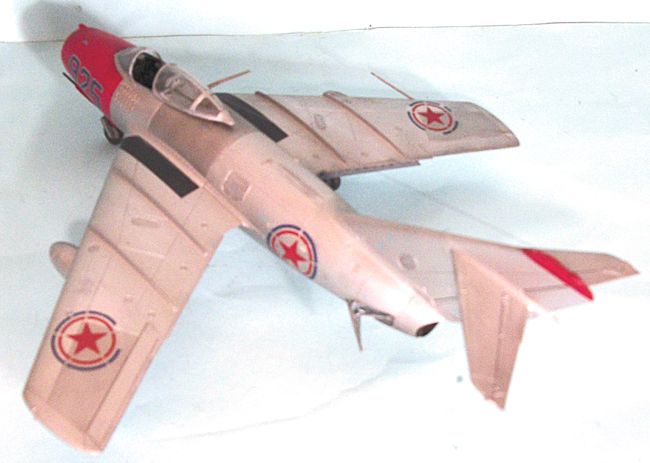 Americans
and their unacknowledged Soviet opponents were fairly evenly matched.
The Soviets at the time had better tactics.
While the Sabres were flying "free hunt" missions far beyond effective
air control, the Soviet fighters were guided to the battlefield by positive
ground control that placed them in the most advantageous position.
Additionally, while there were a number of American flyers with World War
II combat experience, nearly all the Soviet flyers were veterans of the Great
Patriotic War and many were aces from that conflict.
The CO of the 196th Guards Fighter Regiment of the 324th
IAD was Colonel Yevgeny Pepelyaev, a fierce believer in the adage "train hard,
fight easy" who strove "to meet the American standard" with his pilots.
Russian pilots entered combat in formations of three pairs, one to
attack, one to maintain high cover, and a "shield pair" to protect the first
pair. With their altitude
advantage, the Russians almost always initiated combat with a diving attack on
Sabres 10-15,000 feet below them, with the objective of remaining in the
vertical plane with a dive-and-zoom maneuver to counter the superior
maneuverability of the F-86 on the horizontal plane, much like US maneuvers
against Japanese fighters during World War II.
Americans
and their unacknowledged Soviet opponents were fairly evenly matched.
The Soviets at the time had better tactics.
While the Sabres were flying "free hunt" missions far beyond effective
air control, the Soviet fighters were guided to the battlefield by positive
ground control that placed them in the most advantageous position.
Additionally, while there were a number of American flyers with World War
II combat experience, nearly all the Soviet flyers were veterans of the Great
Patriotic War and many were aces from that conflict.
The CO of the 196th Guards Fighter Regiment of the 324th
IAD was Colonel Yevgeny Pepelyaev, a fierce believer in the adage "train hard,
fight easy" who strove "to meet the American standard" with his pilots.
Russian pilots entered combat in formations of three pairs, one to
attack, one to maintain high cover, and a "shield pair" to protect the first
pair. With their altitude
advantage, the Russians almost always initiated combat with a diving attack on
Sabres 10-15,000 feet below them, with the objective of remaining in the
vertical plane with a dive-and-zoom maneuver to counter the superior
maneuverability of the F-86 on the horizontal plane, much like US maneuvers
against Japanese fighters during World War II.
Sergei Komarenko, a 13-victory
Soviet ace (with 12 WW2 victories) described combat between Sabres and MiGs
thus: "The Sabre was the most dangerous threat to my friends and I in Korean
skies. Our MiG-15 and the Sabre belonged in the same class, similar types with
similar performance. They differed only in that the MiG had an advantage in rate
of climb at altitude, while the Sabre was superior in maneuvering, especially at
lower levels. The fight, as a rule, was decided in the first attack.
After the first pass, we reached for altitude, while the Sabres rushed
for the ground. Each tried to reach an altitude where it held a distinct
advantage, and thus the battle faded."
The Russians of the 324th
IAD, the first unit to enter combat in November 1950, were commanded by no less
that COL GEN Ivan Kozhedub, the Allied Ace of Aces of the Second World War with
62 victories. In the aftermath of
the fall of the Soviet Union in 1991, Soviet records became available and we now
know that the Ace of Aces of the Korean War was not 16-victory ace Captain
Joseph McConnell of the 51st FIW,
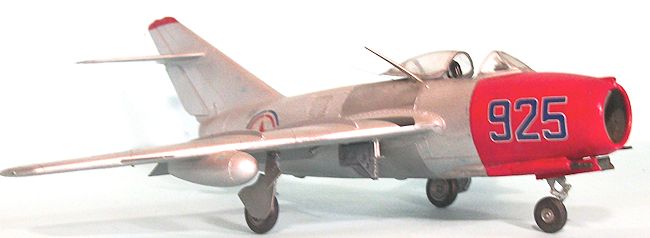 but rather
COL Yevgeny Peplyaev, CO of the 196th IAP, who claimed 21 of the 104 victories
scored by the unit that year. (Some
records claim that the top ace was Nikolai Sutyagin, also of the 196 IAP)
but rather
COL Yevgeny Peplyaev, CO of the 196th IAP, who claimed 21 of the 104 victories
scored by the unit that year. (Some
records claim that the top ace was Nikolai Sutyagin, also of the 196 IAP)
The MiG-15 was not a
dog-fighter. Its heavy cannon
armament was designed to blow apart a B-36 over the Soviet Union at 45-50,000
feet, in the first pass. On
November 18, 1952, US Navy Lieutenant Royce D. Williams of VF-781, flying an
F9F-5 Panther considered completely outclassed by the MiG-15, managed to outfly
and outfight single-handed four Russian-flown MiG-15s, shooting down all.
When Williams landed back aboard USS Oriskany, 184 23mm hits were
counted in the Panther, with one 37mm hit 12 inches from the main spar and 18
inches from the engine - had it hit either the Navy fighter would have been
blown out of the sky. As it was, the airplane was pushed overboard as beyond
salvage.
Revised post-war figures place
USAF claims against the MiG-15 at 375, with admitted F-86 losses of 103, giving
a 3.5:1 kill ratio. This is lower than the wartime claim of 10:1, but still very
respectable. The majority of these
kills, however, date from 1952-53 against Chinese and North Korean opponents.
During the "Honcho Year," Americans and Russians were about even in
admitted losses.
| THE KIT |
There have been four attempts at
doing the MiG-15 in 1/48 scale. The first, by Hawk, arrived in the late 1950s
and is of little interest today other than to kit collectors, being nothing more
than "vaguely" a MiG-15. The
second, the Monogram kit that appeared in 1975, was for 20 years the best MiG-15
available. Unfortunately, Monogram
managed to do their kit in a scale more like 1/40, making the diminutive Soviet
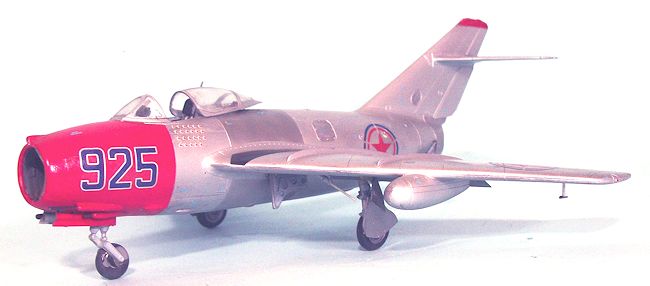 interceptor
as big as its F-86 opponent - the first time I saw a real MiG-15 sitting next to
an F-86 out at Chino in the mid-80s, I knew something was wrong.
Tamiya brought out their MiG-15 in 1995, followed by one released by
Trumpeter in 1999, which is no longer available.
The Tamiya kit has been out of production for several years; I found this
kit at my LHS, a trade from another modeler for a newer kit, priced at its
original $27.00, a bargain I couldn't pass up. Fortunately, I had the long out
of production Eduard photoetch interior set for this kit, as well as an
even-older AeroMaster sheet of MiG aces that included the MiG-15 Yevgeny
Pepelyaev flew for most of his victories.
interceptor
as big as its F-86 opponent - the first time I saw a real MiG-15 sitting next to
an F-86 out at Chino in the mid-80s, I knew something was wrong.
Tamiya brought out their MiG-15 in 1995, followed by one released by
Trumpeter in 1999, which is no longer available.
The Tamiya kit has been out of production for several years; I found this
kit at my LHS, a trade from another modeler for a newer kit, priced at its
original $27.00, a bargain I couldn't pass up. Fortunately, I had the long out
of production Eduard photoetch interior set for this kit, as well as an
even-older AeroMaster sheet of MiG aces that included the MiG-15 Yevgeny
Pepelyaev flew for most of his victories.
| CONSTRUCTION |
I had done several other models
from this kit back 20 years ago when it first appeared.
My memory of it as an easy build was right.
After painting the cockpit and attaching the Eduard details, I glued this
in the forward fuselage and closed it up after filling the area under the
cockpit around the nose wheel well and immediately aft of the cockpit with as
much lead shot as I could get in there, since the model is a notorious tail
sitter otherwise. I also did not
attach the engine, but rather put a bulkhead made with Evergreen sheet in the
rear fuselage to glue the exhaust to, then assembled the rear fuselage and
attached it to the forward fuselage.
The wings and horizontal stabilizer were attached and the model was ready
for paint. Test balance showed
there would be no problem with tail-sitting.
| COLORS & MARKINGS |
I painted the red nose with
Tamiya "Gloss Red," then masked that off and painted the wheel wells
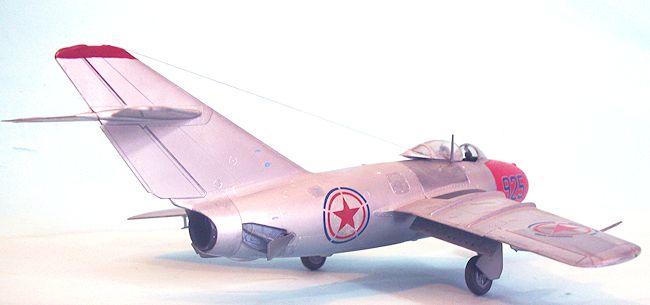 "Russian
blue," then filled them with tissue paper.
The model was painted overall with Alclad Aluminum, with various panels
then masked off and painted with Alclad Duraluminum and White Aluminum.
"Russian
blue," then filled them with tissue paper.
The model was painted overall with Alclad Aluminum, with various panels
then masked off and painted with Alclad Duraluminum and White Aluminum.
I attached the windscreen with
white glue, then posed the canopy in the open position using a couple drops of
CA. The landing gear was attached,
and the dive brakes posed in the open position.
| CONCLUSIONS |
The Tamiya kit is not 100
percent accurate (what model is?), but it is certainly "close enough," and is
still the best MiG-15 out there for anyone who can find it.
It's an easy project that will result in an excellent model.
July 2014
If you would like your product reviewed fairly and fairly quickly, please contact the editor or see other details in the Note to Contributors.